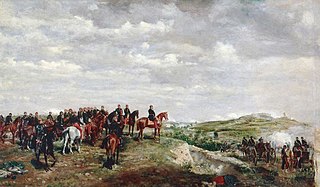
The Second Italian War of Independence, also called the Sardinian War, the Austro-Sardinian War, the Franco-Austrian War, or the Italian War of 1859, was fought by the Second French Empire and the Kingdom of Sardinia against the Austrian Empire in 1859 and played a crucial part in the process of Italian Unification.

Giuseppe Domenico Perrucchetti was an Italian general and politician, the creator of the Alpini corps.
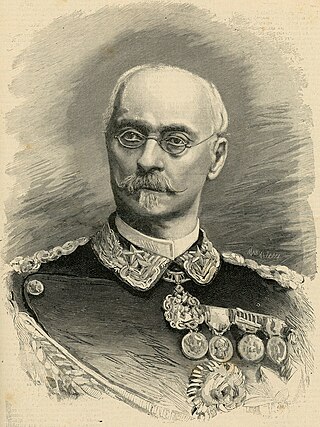
Enrico Cosenz was an Italian soldier born at Gaeta.

The Battle of Varese was fought on 26 May 1859 at Varese (Lombardy). It was an engagement of the Second Italian War of Independence, fought between the Italian volunteers formation of the Hunters of the Alps, led by Giuseppe Garibaldi, against Austrian troops led by Karl von Urban. The Austrian defeat allowed the movement of the Hunters towards Como, and obliged the Austrians to keep troops on the northern part of the front.
San Fermo della Battaglia is a comune (municipality) in the Province of Como in the Italian region of Lombardy, located about 40 kilometres (25 mi) north of Milan and about 3 kilometres (2 mi) southwest of Como. As of 31 December 2004, it had a population of 4,255 and an area of 3.1 square kilometres (1.2 sq mi).
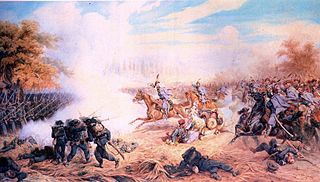
The Third Italian War of Independence was a war between the Kingdom of Italy and the Austrian Empire fought between June and August 1866. The conflict paralleled the Austro-Prussian War and resulted in Austria conceding the region of Venetia to France, which was later annexed by Italy after a plebiscite. Italy's acquisition of this wealthy and populous territory represented a major step in the Unification of Italy.
The Invasion of Trentino was a series of military operations undertaken by the Kingdom of Italy against the Austrian Empire during the Third Italian War of Independence of 1866, which was part of the larger Austro-Prussian War.

Giuseppe Dezza was an Italian general and patriot.

The 22nd Infantry Division "Cacciatori delle Alpi" was an infantry division of the Royal Italian Army during World War II. The division was based in Perugia and named for the Cacciatori delle Alpi corps raised for the Second War of Italian Independence.

Agostino Bertani was an Italian revolutionary and physician during Italian unification.
The 2nd Grenadier Division "Littorio" was one of four divisions raised by Mussolini's Italian Social Republic. Although an infantry formation, it was referred to as a "Grenadier" formation to connect it with preceding Granatieri di Sardegna units.

Karl (Carl) Freiherr von Urban was an Austrian Field Marshal-Lieutenant celebrated for his daring tactics of lightning surprise attacks, often against much stronger forces, which earned him the epithet of Austrian Garibaldi.

Luigi Mercantini was an Italian poet and writer, who took part in the movements for the Italian unification in the late 19th century. He is better known for his poem "La spigolatrice di Sapri", depicting the ill-fated expedition led in 1857 by Carlo Pisacane against the Kingdom of Naples, which was also translated into English by Henry W. Longfellow with the title The Gleaner of Sapri.
Luigi Torro (1836–1900) was an Italian painter.
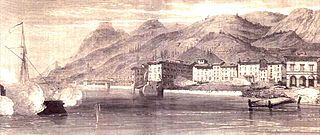
The naval operations on Lake Garda in 1866 during the Third Italian War of Independence consisted of a series of clashes between flotillas of the Kingdom of Italy and the Austrian Empire between 25 June and 25 July that year, as they attempted to secure dominance of the lake. The Austrian fleet, based on the eastern bank of the lake, was larger, more modern and better-armed than their Italian counterpart, and successfully maintained control of the waters, hindering the movement of Italian troops.
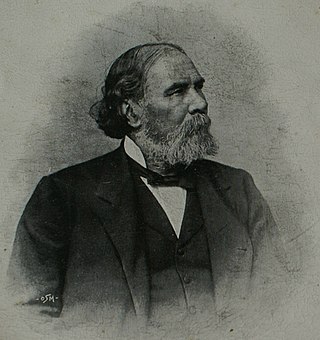
Domenico Menotti Garibaldi was an Italian soldier and politician who was the eldest son of Giuseppe Garibaldi and Anita Garibaldi. He fought in the Second and Third wars of Italian Unification, and organized the Garibaldi Legion, a unit of Italian volunteers who fought for Polish independence in the January Uprising of 1863. He also served in the Chamber of Deputies.
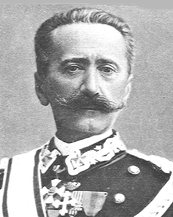
Ettore Pedotti was an Italian general and politician. He served as a Senator of the Kingdom and as Minister of War of the Kingdom of Italy in the successive Giolitti II, Tittoni, and Fortis I governments.

The 1st Artillery Regiment "Cacciatori delle Alpi" is an inactive field artillery regiment of the Italian Army, which was based in Bracciano in Lazio. The regiment was formed in 1871 by the Royal Italian Army. During World War I the regiment served on the Italian front. In 1935 the regiment was assigned to the 22nd Infantry Division "Cacciatori delle Alpi", with which the regiment served in the Greco-Italian War of World War II. In July 1941 the division was sent to occupied Yugoslavia on occupation duty. After the announcement of the Armistice of Cassibile on 8 September 1943 the division and its regiments were disbanded on 11 September by invading German forces.

The 52nd Infantry Regiment "Alpi" is an inactive unit of the Italian Army last based in Portogruaro. The regiment carries the traditions of Giuseppe Garibaldi's Hunters of the Alps, which were formed in spring 1859 for the Second Italian War of Independence. In September 1859, the five Cacciatori delle Alpi regiments were merged into two regiments and integrated into the Royal Sardinian Army's infantry arm. In 1866, the 52nd Infantry Regiment "Alpi" participated in the Third Italian War of Independence. In 1911-12 the regiment fought in the Italo-Turkish War. During World War I, the regiment fought on the Italian front and then on the Western Front. Before the outbreak of World War II, the regiment was assigned to the 22nd Infantry Division "Cacciatori delle Alpi", with which it fought in the Greco-Italian War and was then sent to occupied Yugoslavia as occupation force. After the announcement of the Armistice of Cassibile on 8 September 1943 the division and its regiments were disbanded by invading German forces.

The 48th Infantry Regiment "Ferrara" is an inactive unit of the Italian Army last based in Bari. The regiment is named for the city of Ferrara and part of the Italian Army's infantry arm. On 2 July 1859, during the Second Italian War of Independence, a mobile column was formed with volunteers in Bologna. The column did not see action in the war and was soon split into two columns. On 1 October 1859, the 2nd Mobile Column was renamed 26th Infantry Regiment and assigned, together with the 25th Infantry Regiment to the Brigade "Ferrara" of the Army of the League of Central Italy of the United Provinces of Central Italy. On 1 January 1860, the Brigade "Ferrara" was transferred to the Royal Sardinian Army, and the 26th Infantry Regiments was renumbered 48th Infantry Regiment.
















